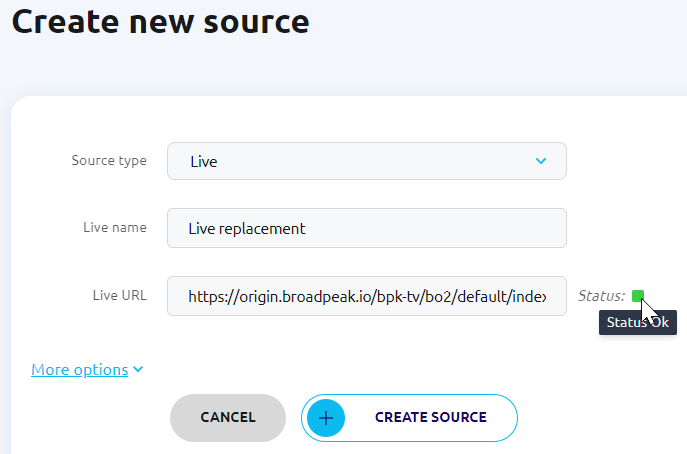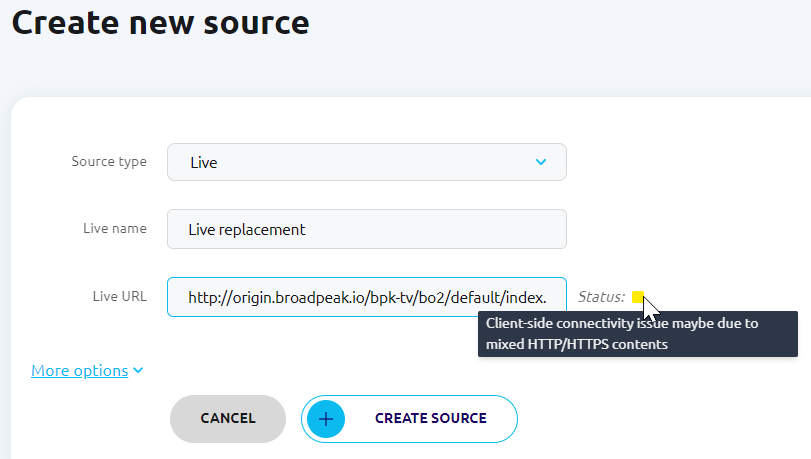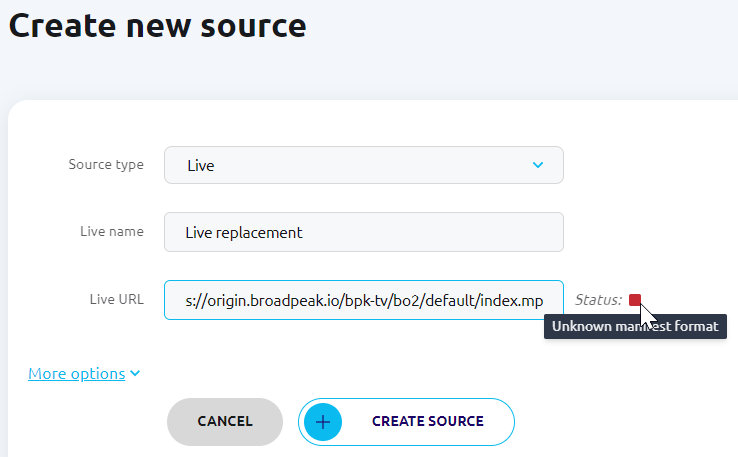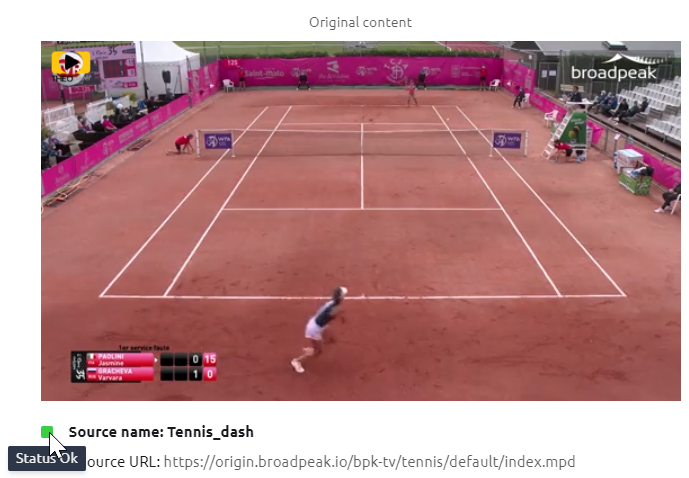OLD - TO DELETE - Concept of Sources
What is it that we call "Source" on broadpeak.io
Sources
A broadpeak.io source is typically defining where your streaming content can be retrieved from, and what type of content media is being used. For some applications, other objects are also defined as sources (e.g. Ad Server for Targeted Ad).
A source is uniquely defined (independently of applications). The API to create, read, update or delete Sources can be found here: link.
Source Type
As shown below, there are 5 types of Sources which can be created, updated or deleted through the WebApp or the API.
| Source type | Description | Parameters |
|---|---|---|
| Ad Server | A link to an ad server compliant with the VAST or VMAP protocols, which will tell broadpeak.io which ads should be played within an ad placement opportunity, depending on the context | Name: must be unique among all sources. URL: must point to a valid ad server that broadpeak.io can connect to. Query parameters: static or dynamic variables forwarded from the client request or inserted by broadpeak.io to communicate the context to the Ad Server. Description: informational only. |
| Asset Catalog | A link to a directory containing DASH and/or HLS VOD assets | Name: must be unique among all sources. URL: the common part of the path of all assets in the catalog. It must end with a /. Sample: one of the VOD assets contained in the catalog. Combined with the above URL, it must link to a valid DASH or HLS VOD asset for validation purposes. Backup origin IP: IP address of a backup server used when the primary address is unreachable. Description: informational only. |
| Asset | A link to a DASH or HLS VOD asset that can be used as content in a Virtual Channel slot or a gap filler in an Ad Insertion service | Name: must be unique among all sources. URL: must link to a valid DASH or HLS VOD asset. Backup origin IP: IP address of a backup server used when the primary address is unreachable. Description: informational only. |
| Live | A link to a DASH or HLS live channel that can be used as original source in a service or replacement content in a Content Replacement or Virtual Channel service | Name: must be unique among all sources. URL: must link to a valid DASH or HLS live channel. Backup origin IP: IP address of a backup server used when the primary address is unreachable. Description: informational only. |
| Slate | A VOD asset transcoded from a JPEG still picture or an mp4 video, that can be used as gap filler in an Ad Insertion service. Requires a transcoding profile compatible with your live source. | Name: must be unique among all sources. URL: must link to a valid JPEG file (up to 50 MB) or mp4 video (up to 500 MB). Description: informational only. |
Source Format
You can define only one combination of streaming format per source (e.g. DASH or HLS). This level of granularity is intended to provide the maximum level of flexibility and to allow you to select specific source variants in your services. Therefore, you need to define multiple source variants if you have multiple combinations (e.g. packaging formats, packaging formats versions, DRM versions, etc.).
The table below indicates what sources can be used in which service:
| Application | Original content | Alternative content (replacement or ad insertion) |
|---|---|---|
| Dynamique Ad Insertion | Live Asset catalog | Ad server Slate |
| Virtual Channel | Live | Live Asset Ad server Slate |
| Content replacement service | Live | Live Asset |
Live and
Live and asset source have the same attributes.
Live sources must provide open manifests while asset sources must provide closed manifests.
| Parameter | Description |
|---|---|
| Name | String (must be unique accross all applications) |
| URL | Streaming URL on your origin/CDN |
| Backup origin IP* | Backup IP address of origin to use in case the manifest cannot be read from the URL (HTTP only) |
Asset sources attributes
Asset Catalogue
AD Decision Server
As shown below, there are 5 types of Sources which can be created, updated or deleted through the WebApp or the API.
| Source type | Description | Parameters |
|---|---|---|
| Ad Server | A link to an ad server compliant with the VAST or VMAP protocols, which will tell broadpeak.io which ads should be played within an ad placement opportunity, depending on the context | Name: must be unique among all sources. URL: must point to a valid ad server that broadpeak.io can connect to. Query parameters: static or dynamic variables forwarded from the client request or inserted by broadpeak.io to communicate the context to the Ad Server. Description: informational only. |
| Asset Catalog | A link to a directory containing DASH and/or HLS VOD assets | Name: must be unique among all sources. URL: the common part of the path of all assets in the catalog. It must end with a /. Sample: one of the VOD assets contained in the catalog. Combined with the above URL, it must link to a valid DASH or HLS VOD asset for validation purposes. Backup origin IP: IP address of a backup server used when the primary address is unreachable. Description: informational only. |
| Asset | A link to a DASH or HLS VOD asset that can be used as content in a Virtual Channel slot or a gap filler in an Ad Insertion service | Name: must be unique among all sources. URL: must link to a valid DASH or HLS VOD asset. Backup origin IP: IP address of a backup server used when the primary address is unreachable. Description: informational only. |
| Live | A link to a DASH or HLS live channel that can be used as original source in a service or replacement content in a Content Replacement or Virtual Channel service | Name: must be unique among all sources. URL: must link to a valid DASH or HLS live channel. Backup origin IP: IP address of a backup server used when the primary address is unreachable. Description: informational only. |
| Slate | A VOD asset transcoded from a JPEG still picture or an mp4 video, that can be used as gap filler in an Ad Insertion service. Requires a transcoding profile compatible with your live source. | Name: must be unique among all sources. URL: must link to a valid JPEG file (up to 50 MB) or mp4 video (up to 500 MB). Description: informational only. |
Source Status
The WebApp and the API provide information about the status of your sources. The objective is to ensure you have visibility on the content (input feeds) used in your broadpeak.io Services definitions.
Source status on the WebApp
The source status displayed by the WebApp is based upon server side and client side checks.
The first check is performed server side. The client side check is done only if the server side test passes.
As client side check are impacted by web browser policies (e.g. security), a warning on the WebApp does not necessarily mean that your source is going to have the same status when used by the broadpeak.io platform.
Wherever a colored icon is displayed next to a source in the WebApp, it is reflecting the source status. In this case, by default, the refresh period is 4 seconds. If you hover your mouse over this icon, you will get additional information thanks to a tool tip. Note that source status will soon be added in the list of sources (link)
List of typical source statuses
| Status | Color code | Sample source URL | Description |
|---|---|---|---|
| Status OK | Green | https://origin.broadpeak.io/bpk-tv/bo2/default/index.mpd | Manifest can be read |
| Client side connectivity issue | Yellow | http://origin.broapeak.io/bpk-tv/bo2/default/index.mpd | Manifest can be read on server side but not on client side |
| Request failed with status code 404 | Red | https://origin.broadpeak.io/bpk-tv/bo/default/index.m3u8 | Manifest not found on the origin or CDN |
| Status failed with status code 403 | Red | https://api.broadpeak.io/v1/sources/check/index.m3u8 | The provided source URL requires authentication or authorization |
| Timeout of 2900 ms exceeded | Red | https://tmp.ridgeline.fr/badmanifest.m3u8 | Manifest reading takes too long |
For live sources, there are 3 possible statuses

Status OK

Client-side connectivity issue maybe due to mixed HTTP/HTTPS contents

Unknown manifest format
In the Preview, the source status is highlighted as shown below

Source status API
It is also possible to use te API to retrieve the status of a source here
Updated about 1 year ago
